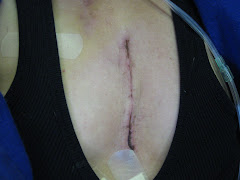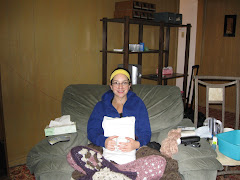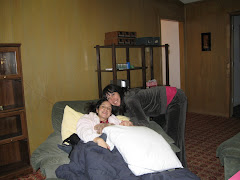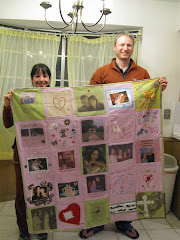
 The Goal: 1) Surgery to insert Central Line IV 2). Begin Flolan medication.
The Goal: 1) Surgery to insert Central Line IV 2). Begin Flolan medication.
Now that surgery is a possibility we have a new goal in sight; get my Pulmonary Vascular Resistance (PVR) pressures down.
As I mentioned, my PVR pressures are at 10 and they need to go down to the 6-8 range for surgery. Flolan is the Dr.'s drug of choice to assist with getting my pressures down. It is not only the oldest PH drug but also the most potent.
The first time Dr. Torres familiarized me with all the PH therapies was in Jan. 2008, prior to the Congenital Heart Defect diagnosis. As a PH patient, being put on Flolan is a good indicator that other therapies are not effective. In addition, Flolan often times is a long term and in even lifetime solution. Therefore, at that time I feared being put on this drug. I don't think I need to explain further, just look at the above pictures of me and the Flolan pump to see what's involved. Because there is an opportunity to fix the defect with surgery, and even cure the PH caused by the defect, I remain hopeful that the Flolan therapy is a short term solution.
Process: Arrive in Dallas on Saturday, July 26th. The usual crew; Chris and my parents. We spend Sunday and Monday training with Steven, the Accredo Pharmaceutical Nurse. He familiarizes us with mixing the drug and managing the pump. The processes and responsibilities involved with this drug is overwhelming. Not following the processes can result in; an accidental *bolus or the opposite, due to the drugs *half life of 3-6 minutes.
On Tuesday, July 29th I get the catheter inserted and start on Flolan. I am in the ICU for 2 days being closely monitored. This is protocol for anyone who starts this medication. After the first day Dr. Torres gives me the option for discharge. I think he felt confident in my abilities to manage the Flolan but also felt comfortable releasing me to my mother, the CNP. Either way, I wasn't ready, the thought of managing this drug was a little scary. We agreed that I'd stay another day and continue to increase my dosing.
I recall talking to my mom about the above events, prior to the visit. I mentioned that the stay in the ICU would be "restful" after a central line insertion and starting the Flolan. She responded with "The hospital is not a place to rest". My interpretation, although also true, if a patient is well enough to go home they are discharged.....it is not a hotel. What I did not anticipate, was that I would be interrupted from sleep every couple of hours to check vitals, change ice packs for medication, increase dosing, etc. This is in addition to the leads/wires, oxygen and IV connected and hanging from my body. All I can say is I slept very well in my hotel room that night after being released from the hospital. The entire trip was about 7 days; 2 days traveling; 2days training; and 3 days in the hospital.
Since July 29th, I have been increasing my dose every three days. I am now very comfortable mixing my medication and changing my dressing at the catheter site. As of October 10th, I have reached the goal for my dosing (30 ng/kg/min). I will remain at this dose until November 10th, my next visit to Dallas. During this visit, I will have yet another hearth catheterization to check my pressures. Keep your fingers crossed for me.
Additions to Daily/Weekly Activities Include; 1) Mixing medication on a daily basis 2). Carrying along back-up supplies and pump wherever I go. Not only has it added to my physical activities it has added to my mental activities. I have to remember that I have and IV coming out of my chest with about a 5 pound weight at the end of it. I frequently get up from the couch or bed and start walking away and then will feel a tug, reminding me of the extra luggage. Also, the added accessory of a fanny pack is not one that I favor. What can you do?
Medications: Oxygen (I am now able to be off the oxygen for periods of the day when I am relaxing and not doing a whole lot of activity), Bosantan, Warfarin, Flolan
Flolan side effects; jaw pain, which is similar to putting a sour candy in my mouth. This occurs every time I put something in my mouth; flushing, which looks like I have a sun burn on my face. In August, I developed a bad rash around my catheter sight. It was so uncomfortable that I just wanted to scratch my skin off. I became so obsessed that the rash spread throughout my chest and Chris had to initiate an intervention....a sarcasm intervention. Luckily sarcasm goes a long way in our house. That rash lasted about 3-4 weeks and is now completely gone.
New Phrases: Chris asks me now "How's it Flowing" Meaning, how's the O2 and Flolan flowing.
*Bolus is to administer a "large" dose of IV medication. A bolus of Flolan is highly discouraged within the medical community because it is a potent drug. Because patients mix and manage there own medication there is a window of opportunity for this to happen and also a common occurrence. Loosing consciousness, vomiting are just a couple of negative effects when a bolus occurs.
*The half-life of a drug is how long it takes for half of it to be eliminated from the bloodstream. For Flolan if I am not receiving the medication for 3-6 minutes I would have a similar reaction to a bolus.



























